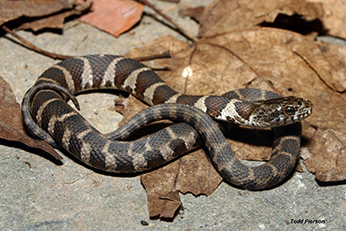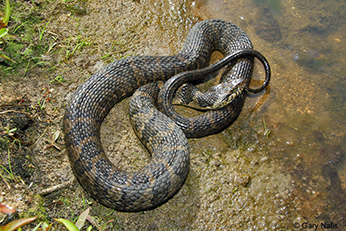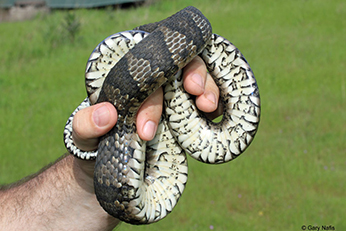(Nerodia sipedon)
General Description
 Northern watersnakes have dark crossbanding. Photo by Todd Pierson.
Northern watersnakes have dark crossbanding. Photo by Todd Pierson.
 An adult northern watersnake in Placer County. Photo by Gary Nafis, California Herps(opens in new tab).
An adult northern watersnake in Placer County. Photo by Gary Nafis, California Herps(opens in new tab).
 The ventral side of northern watersnakes can be white, yellow, or orange, and commonly have dark half-mooned shaped spots. Photo by Gary Nafis, California Herps(opens in new tab).
The ventral side of northern watersnakes can be white, yellow, or orange, and commonly have dark half-mooned shaped spots. Photo by Gary Nafis, California Herps(opens in new tab).
Northern watersnakes are heavy-bodied, aquatic snakes that range from 2 to 4 ½ feet in length. There are four subspecies of northern watersnake: Lake Erie, midland, common, and Carolina. All subspecies have black, dark brown, or reddish crossbands on the front section of the body that break up into rows of blotches from the middle to the end of the body. Their bellies can be white, yellow, or orange, and commonly have dark half-mooned shaped spots. Body color of northern watersnakes can vary from reddish to brown to gray to black. Older northern watersnakes often appear to be almost entirely dark brown or black in color. Northern watersnakes are not venomous, but when threatened will strike repeatedly and emit a foul-smelling musk mixed with feces.
Current Distribution
In California, northern watersnakes have been established and reproducing in Kaseberg Creek in the City of Roseville, Placer County since 2007. In 2014, they were discovered in another separate location within Roseville. Northern watersnakes do not naturally occur west of the Rocky Mountains. They are native to the eastern United States from Mississippi and Alabama, through the Carolinas to Maine in the east, and through Kansas and Nebraska to the Great Lakes region in the north.
Habitat Preference
Northern watersnakes live in freshwater habitats such as ditches, ponds, lakes, wetlands, and slow-moving streams and rivers. They are commonly found basking in the sun in shallow water areas on natural and manmade structures such as overhanging branches, logs, docks, and piers. When they aren’t basking, northern watersnakes can be found hiding under logs, flat rocks, boards, and other cover near the water’s edge. Northern watersnakes are able to leave water and travel overland, but never venture too far from their freshwater habitats.
Pathways
Though watersnakes are not uncommon in the pet trade, their ill temperament and unpleasant smell make them poor pets. As a result, the most likely pathway of their introductions into California and other non-native environments is by intentional or accidental release by pet owners. In 2008, all species of the genus Nerodia were listed as restricted species in California, and thus cannot be imported, transported, or possessed without a permit.
Impacts
Northern watersnakes are aquatic predators that primarily prey upon fish and amphibians, and may cause a direct threat to the state’s threatened and endangered fish and amphibian populations. Though California was historically void of watersnakes, several of California’s native garter snakes (genus Thamnophis), commonly occupy the state’s aquatic habitats. Expansion of non-native watersnake populations will likely cause direct competition with native garter snakes, including the state and federally threatened giant garter snake (Thamnophis gigas).
Actions Taken if Found
If you observe this species in California, please report your sighting to the CDFW Invasive Species Program, by email to Invasives@wildlife.ca.gov. If you catch, or are currently in possession of a watersnake, do not release it. Immediately contact the CDFW Invasive Species Program at (866) 440-9530 for assistance.
Additional Resources